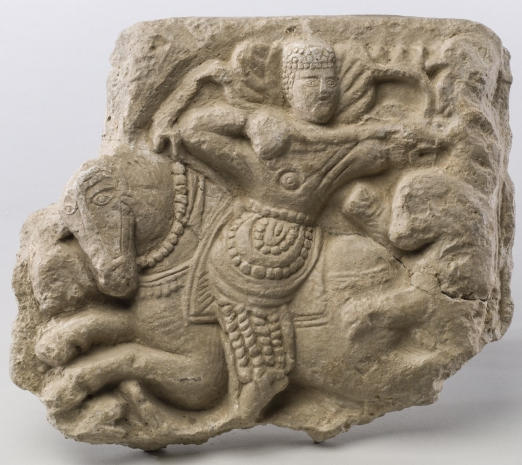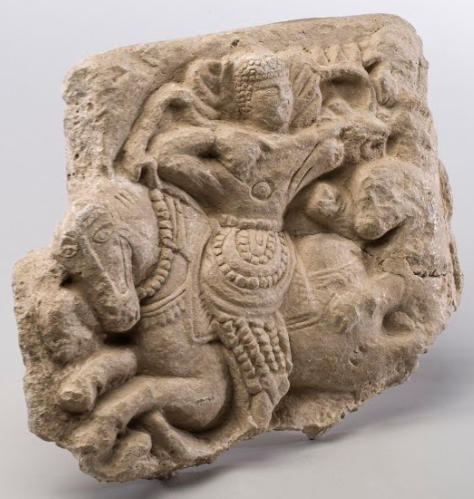|
|

Fragment (Relief), ident. Nr.: I, 4424
© Foto: Museum für Islamische Kunst, Staatliche Museen zu Berlin
Fotograf/in: Johannes Kramer
Details
Fragment einer rechteckigen, modelgeformten Stuckreliefplatte mit Darstellung eines rückwärtsgewandten, Bogen spannenden Reiters. Das Gesicht des Reiters und der Pferdekopf sind halbfrontal wiedergegeben und steigern mit ihrer diametralen Ausrichtung die Dynamik des stark bewegten Bildes. Der seitliche gefiederte Besatz der mit einer kleinteilig gegliederten Kopfbedeckung geschmückten Kopfdarstellung deutet an, dass es sich um einen Großkönig handelt. Daneben sind ebenfalls das Gewand, die Beinkleider, das Zaumzeug und die Satteldecke als üppig dekoriert angedeutet. Das Pferd befindet sich im Sprung, es wird hinten von einem Bären (?) angegriffen. Unter dem linken Vorderbein weisen Reste auf plastisch angedeutete Geländeunebenheiten und Bewuchs hin. So kann von einer Jagdszenerie in freier Natur ausgegangen werden.
Das Stück wurde im Kunsthandel erworben und stammt wohl aus dem Ktesiphongebiet.
Material/Technique: Kalk-Sand-Gemisch, modelgeformt, geschnitten
Measurements: Höhe: 17,5 cm; Breite: 20,5 cm; Tiefe: 3 cm
Fragment of a rectangular, model-formed stucco relief plate depicting a backward-facing, horsearcher.
The rider's face and the horse's head are reproduced half-frontally and, with their diametrical alignment, increase the dynamism of the strongly moving image.
The feathered trimmings on the side of the head, which is decorated with a headgear with small pieces, indicates that it is a great king.
In addition, the garment, the trousers, the bridle and the saddlecloth are indicated as lavishly decorated.
The horse is jumping, it is being attacked by a bear (?) from behind. Remnants under the left front leg indicate vividly indicated uneven terrain and vegetation.
A hunting scene in the wild can thus be assumed.
The piece was acquired in the art trade and probably comes from the Ctesiphon area.
Material / Technique: Lime-sand mixture, model-formed, cut
Measurements: Height: 17.5cm; Width: 20.5 cm; Depth: 3 cm
Source: smb.museum-digital.de
|



